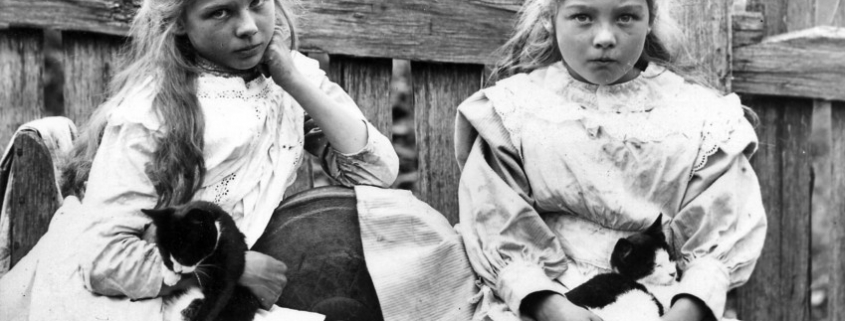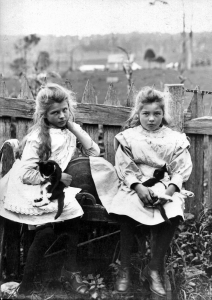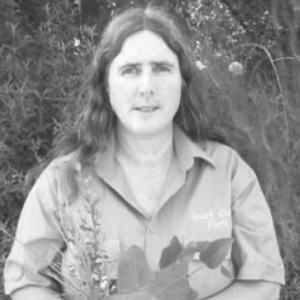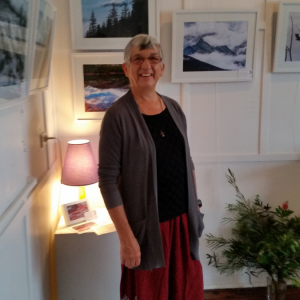Through the lens: images of Pearl Corkhill (1887-1985)
William Henry Corkhill (1846-1936) took evident delight in photographing his family at their property, “Marengo”, in Tilba Tilba. His three children, Edith, Pearl (her first name was Elizabeth but she was known by her second) and Norman, with assorted pets, feature prominently as subjects, his wife Frances née Bate less so. The heritage of the Triangle region is infinitely indebted to both the father and his daughter, Pearl, for the unique photographic record he left of the area, he for its creation and she for its preservation.
Corkhill, since migrating to New South Wales as a boy, had been employed variously in the district, notably as a cheesemaker. But around 1890 he turned to photography professionally. Over a period of twenty years he took photographs mainly of Tilba Tilba and Central Tilba but also the wider setting of Bermagui, Wallaga Lake and Cobargo. He recorded the lives of the settlers: individuals, families (many of their descendants residing here today), social and sporting events, buildings (most still easily identifiable), gold mining on Gulaga and timber felling, farming and prized farm animals. Indigenous history is represented too, with portraits, group photographs from Wallaga Lake and photographs of the impressive funeral of Queen Narelle attended by Indigenous and non-Indigenous residents alike. There is no comparable comprehensive pictorial record of village life in the pre-Federation and early post-Federation years of this country.
It came to be preserved because, after her brother Norman died, Pearl discovered the glass plates which held the precious negatives stored in dusty boxes under his house. Planting the boxes on the table of her friend and local historian Norm Hoyer, she asked “What should I do with these?” To which he replied, “We should give them to the nation”. She offered the plates to the National Library of Australia, which gratefully accepted them, but Pearl and Norm then took on the massive task of captioning the photos from their local knowledge. The collection can be viewed online as digital images on the NLA website and also at the Bermagui Museum (next to the Information Centre) which holds an enhanced digital archive thanks to the dedication of Bermagui photographer Dave Cotton who devoted countless hours to restoration and enhancement. The results are superb. All of the printable photographs, 840 of them, have been published in Diana Watson’s Negatives of Glass (2010) which, like the prints, can be purchased from the Museum.
The Pearl Corkhill we see in the collection matures from a little girl with a direct, but sometimes dreamy, or perhaps just self-contained, gaze into a composed young woman attired in nursing uniform. As captured on the glass plates, the childhood she spent with her brother and sister looks a storybook one, with picnics on Mount Dromedary, excursions to the beach spent wading or clambering over rocks, beloved cats (sometimes in little dresses), dogs and goat with cart, horse-riding side-saddle. She reportedly became an excellent horsewoman and would organise moonlight rides to Wallaga Lake for friends and relations.
Pearl’s life could not have changed more radically after she enlisted as a nurse in the Australian Imperial Force in 1915, serving both in Egypt and on the Western Front in World War 1. According to the citation, her “courage and devotion” during an air raid near Abbeville in France, when she continued tending the injured heedless of her own safety, earned her the Military Medal, an award conferred on only seven Australian nurses in the Great War.
After the War was over Pearl returned to Australia and continued her nursing career, her last appointment being that of senior sister at Bega District Hospital. She retired to Akolele. A photograph shows her as a spry, bright-eyed nonagenarian posing at the top of Gulaga. She had been taken to the summit by tractor. Her father, a man whose portraits reveal sharp insight into his fellow humans tempered by a wry sense of humour, would have been amused – and proud.
Stephanie Anderson



